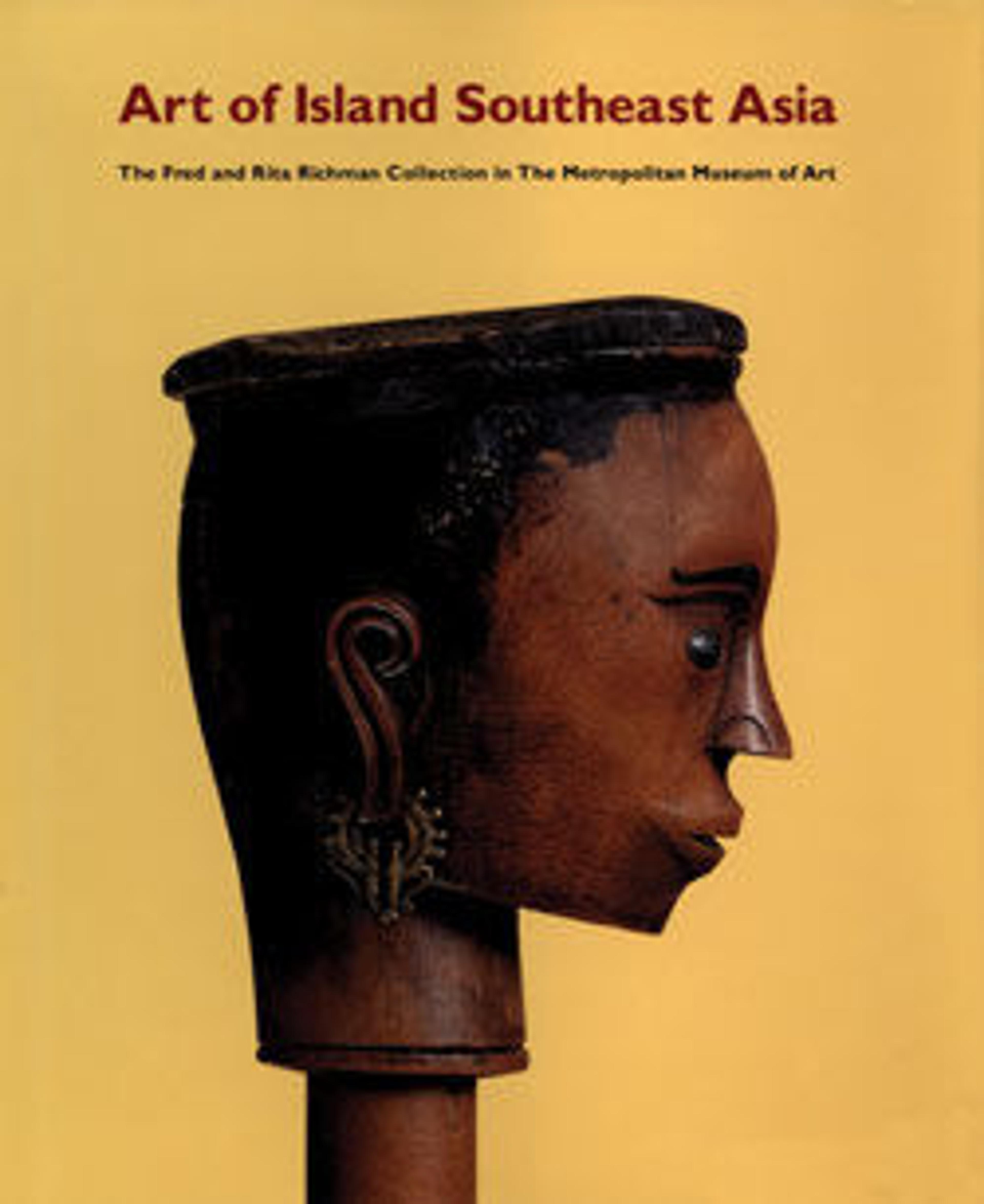Piso sanalenggam (sword)
This sword’s hilt depicts a kneeling figure tilting slightly forward, hands resting on bent knees. The arms are adorned with metal bands above the elbows and elongated earlobes are also made of metal, possibly depicting elaborate ear ornaments called duri-duri. The figure is wearing a large headdress that flares outward, revealing an interior cavity that could hold pukpuk, a powerful substance made with ritually prepared human and animal remains. The shape of this knife suggests it is a piso sanalenggam, with a wide blade and a curving, S-shaped edge. While most of the decorative elements are found on the hilt, the blade itself features a copper and brass inlay in the shape of a sun.
Swords of this type are usually associated with Toba and Pakpak Batak, two of the six groups among the Batak peoples of northern Sumatra. Living in the mountainous highlands surrounding Lake Toba (the birthplace of the Batak, according to oral histories and myths), the Batak maintained trade relations with their Malay neighbors living on the coast but otherwise remained relatively isolated until the 18th and 19th centuries when Dutch and British traders, along with German missionaries, established operations in Sumatra. Although nearly all Batak today are Christian or Muslim, they formerly recognized diverse supernatural beings, including deities, ancestors, and malevolent spirits. The primary religious figures in Batak society were male ritual specialists, called datu by the Toba Batak, who acted as intermediaries between the human and spiritual worlds. Much of Batak sacred art centered on the creation and adornment of objects—including the piso sanalenggam—that would be used by the datu for divination, curing ceremonies, malevolent magic, and other rituals. Among the most important objects were ceremonial staffs, books of ritual knowledge, and a variety of containers used to hold magical substances.
References
Capistrano-Baker, Florina H. Art of Island Southeast Asia. The Fred and Rita Richman Collection in The Metropolitan Museum of Art. New York: The Metropolitan Museum of Art, 1994, pp.66
Sibeth, Achim. The Batak. London: Thames and Hudson, 1991.
Sibeth, Achim and Bruce W. Carpenter. Batak Sculpture. Singapore: Editions Didier Millet, 2007, pp.234–263
Swords of this type are usually associated with Toba and Pakpak Batak, two of the six groups among the Batak peoples of northern Sumatra. Living in the mountainous highlands surrounding Lake Toba (the birthplace of the Batak, according to oral histories and myths), the Batak maintained trade relations with their Malay neighbors living on the coast but otherwise remained relatively isolated until the 18th and 19th centuries when Dutch and British traders, along with German missionaries, established operations in Sumatra. Although nearly all Batak today are Christian or Muslim, they formerly recognized diverse supernatural beings, including deities, ancestors, and malevolent spirits. The primary religious figures in Batak society were male ritual specialists, called datu by the Toba Batak, who acted as intermediaries between the human and spiritual worlds. Much of Batak sacred art centered on the creation and adornment of objects—including the piso sanalenggam—that would be used by the datu for divination, curing ceremonies, malevolent magic, and other rituals. Among the most important objects were ceremonial staffs, books of ritual knowledge, and a variety of containers used to hold magical substances.
References
Capistrano-Baker, Florina H. Art of Island Southeast Asia. The Fred and Rita Richman Collection in The Metropolitan Museum of Art. New York: The Metropolitan Museum of Art, 1994, pp.66
Sibeth, Achim. The Batak. London: Thames and Hudson, 1991.
Sibeth, Achim and Bruce W. Carpenter. Batak Sculpture. Singapore: Editions Didier Millet, 2007, pp.234–263
Artwork Details
- Title: Piso sanalenggam (sword)
- Artist: Toba Batak artist
- Date: late 19th–early 20th century
- Geography: Indonesia, Sumatra
- Culture: Toba Batak
- Medium: Water buffalo horn, copper/zinc alloy (sun inlay and end of the handle), lead (necklace and eyes of the handle figure), iron alloy
- Dimensions: L. 21 in. (53.3 cm)
- Classifications: Bone/Ivory-Implements, Ivories-Horn, Metal-Implements
- Credit Line: Gift of Fred and Rita Richman, 1988
- Object Number: 1988.143.23
- Curatorial Department: The Michael C. Rockefeller Wing
More Artwork
Research Resources
The Met provides unparalleled resources for research and welcomes an international community of students and scholars. The Met's Open Access API is where creators and researchers can connect to the The Met collection. Open Access data and public domain images are available for unrestricted commercial and noncommercial use without permission or fee.
To request images under copyright and other restrictions, please use this Image Request form.
Feedback
We continue to research and examine historical and cultural context for objects in The Met collection. If you have comments or questions about this object record, please contact us using the form below. The Museum looks forward to receiving your comments.
